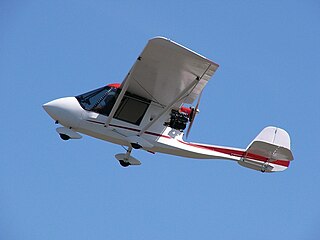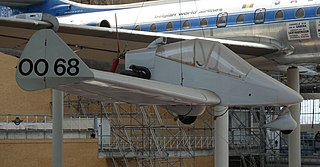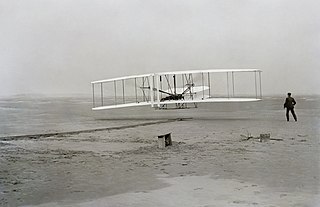
The Quad City Challenger is a family of one and two seats-in-tandem, pusher configuration, tricycle landing gear ultralight aircraft that is designed and produced by Quad City Aircraft Corporation of Moline, Illinois. The Challenger was first introduced in 1983.

The CGS Hawk is a family of high wing, strut-braced, pusher configuration, single and two-seats-in-tandem ultralight aircraft, designed by Chuck Slusarczyk and manufactured by CGS Aviation.
The Latécoère 225 was an unusual single seat canard microlight amphibian, with a swept wing, and of pusher configuration. It first flew in 1984 but was not put into production.

The Club ULM Rotor Ptenets-2 is a Russian ultralight aircraft, designed and produced by Club ULM Rotor of Kumertau, Bashkortostan. The aircraft is supplied as a complete ready-to-fly-aircraft.
The Anglin J6 Karatoo is an Australian ultralight and light-sport aircraft that was designed by Jessie Anglin and introduced in 1982. Over the years the J6 Karatoo has been produced by several different manufacturers, including Amax Engineering of Donvale, Victoria, Skyway Aircraft and is currently built by Serenity Aviation of Australia. The aircraft is supplied as plans or as a kit for amateur construction.
The Summit Steel Breeze is an American powered parachute, designed and produced by Summit Aerosports of Yale, Michigan. The aircraft is supplied as a kit for amateur construction or as a complete ready-to-fly aircraft.
The Blessing Rebell was a one/two seat motorglider designed for amateur construction in Germany. Only one was built, flying for the first time in 1973 in a pusher configuration. It was later modified and flew in 1980 as a tractor aircraft.
The ViS Sprint is a pusher configuration, pod-and-boom two-seat ultralight, designed and built in the Ukraine in the mid-2000s. It can serve as an agricultural spraying aircraft.
The Silent Family Silent Glider M is a German ultralight trike motor glider, designed by Helmut Grossklaus and produced by Silent Family of Westerrade. The aircraft is supplied as a complete ready-to-fly-aircraft.
The Alliant Destiny Fusion is an American two-seat powered parachute, designed and produced by Alliant Aviation based at Richland, Michigan.
The Landray GL.02 Ami Pou was a very basic, low-powered French tandem wing, single-seat sports aircraft. The only example flew in 1979.
The Landray GL.03 Pouss Pou was a small, pusher configuration tandem wing aircraft built in France in the early 1980s. Only one was completed, though it was much modified.
The Barbaro RB-50 was a small, French, high wing single engine light aircraft, amateur built in the 1960s. Only one was completed.

The Payen Arbalète was a small, pusher configuration, experimental French tailless aircraft first flown in 1965.
The Payen Pa.47 Plein Air was a French two seat, high wing single engine tourer, which first flew in 1949. Only one was built.
The SNCASE SE-700 was a three-seat passenger autogyro designed during World War II. Two were completed but only the first flew and the programme was soon abandoned.
The Piel CP-10 was a post-war French sports aircraft in the Pou du Ciel tradition and was the first design from Claude Piel to fly.

The French tailless Pottier P.40 was the first aircraft designed by Jean Pottier. It flew in 1975.
The S.E.C.A.T.-VI La Mouette or S.E.C.A.T. 60T La Mouette was a French two seat tourer built shortly before the outbreak of World War II.

The RRG Storch V was the only member of Alexander Lippisch's Storch series of tailless aircraft to be powered. It flew successfully in 1929.















